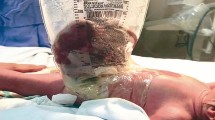Abstract
Purpose
Current literature regarding outcomes of gastroschisis closure methods do not highlight differences in patients who successfully undergo primary closure with those who fail and require silo placement. We hypothesize that failure of primary closure has significant effects on clinical outcomes such as length of stay and time to enteral feeding.
Methods
We conducted a retrospective review between 2009 and 2018 of gastroschisis patients at a tertiary pediatric referral hospital. We compared patients successfully undergoing primary closure to patients who failed an initial primary closure attempt. Bivariate and multivariate linear regression models were used to assess the association of closure method on clinical outcomes.
Results
Sixty-eight neonates were included for analysis, with 44 patients who underwent primary closure and 24 who failed primary closure. On multivariate regression analysis, primary closure patients had shorter estimated time to starting and to full enteral feeds and decreased LOS as compared to those who failed primary closure. Two patients (4.44%) had complications related to primary closure.
Conclusion
Patients able to undergo primary closure for gastroschisis were more likely to have a shorter length of stay, shorter time to enteral feeds, and use much fewer medical resources. Initial primary closure is a safe method for most patients.

Similar content being viewed by others
References
Stallings EB, Isenburg JL, Short TD et al (2019) Population-based birth defects data in the United States, 2012–2016: a focus on abdominal wall defects. Birth Defects Res 111:1436–1447
Kunz SN, Tieder JS, Whitlock K et al (2013) Primary fascial closure versus staged closure with silo in patients with gastroschisis: a meta-analysis. J Pediatr Surg 48:845–857
Gurien LA, Dassinger MS, Burford JM et al (2017) Does timing of gastroschisis repair matter? A comparison using the ACS NSQIP pediatric database. J Pediatr Surg 52:1751–1754
Murthy K, Evans JR, Bhatia AM et al (2014) The association of type of surgical closure on length of stay among infants with gastroschisis born>/=34 weeks’ gestation. J Pediatr Surg 49:1220–1225
Banyard D, Ramones T, Phillips SE et al (2010) Method to our madness: an 18-year retrospective analysis on gastroschisis closure. J Pediatr Surg 45:579–584
Keene ON (1995) The log transformation is special. Stat Med 14:811–819
Duan N (1983) Smearing estimate: a nonparametric retransformation method. J Am Stat Assoc 78:605–610
Hawkins RB, Raymond SL, St Peter SD et al (2019) Immediate versus silo closure for gastroschisis: results of a large multicenter study. J Pediatr Surg S0022–3468:30509–30513
Molik KA, Gingalewski CA, West KW et al (2001) Gastroschisis: a plea for risk categorization. J Pediatr Surg 36:51–55
Kidd JN Jr, Jackson RJ, Smith SD et al (2003) Evolution of staged versus primary closure of gastroschisis. Ann Surg 237:759–764 ((discussion 764-755))
Poola AS, Aguayo P, Fraser JD et al (2019) Primary closure versus bedside silo and delayed closure for gastroschisis: a truncated prospective randomized trial. Eur J Pediatr Surg 29:203–208
Petrosyan M, Sandler AD (2018) Closure methods in gastroschisis. Semin Pediatr Surg 27:304–308
DeUgarte DA, Calkins KL, Guner Y et al (2020) Adherence to and outcomes of a University-Consortium gastroschisis pathway. J Pediatr Surg 55:45–48
Zalles-Vidal C, Peñarrieta-Daher A, Bracho-Blanchet E et al (2018) A Gastroschisis bundle: effects of a quality improvement protocol on morbidity and mortality. J Pediatr Surg 53:2117–2122
Neu J, Walker WA (2011) Necrotizing enterocolitis. N Engl J Med 364:255–264
Hook-Dufresne DM, Yu X, Bandla V et al (2015) The economic burden of gastroschisis: costs of a birth defect. J Surg Res 195:16–20
Wong M, Oron AP, Faino A et al (2020) Variation in hospital costs for gastroschisis closure techniques. Am J Surg 219:764–768
Kumar JA, Teckman JH (2015) Controversies in the mechanism of total parenteral nutrition induced pathology. Children (Basel) 2:358–370
Snyder AN, Burjonrappa S (2020) Central line associated blood stream infections in gastroschisis patients: a nationwide database analysis of risks, outcomes, and disparities. J Pediatr Surg 55:286–291
Hartman M, Martin AB, Benson J et al (2020) National health care spending in 2018: growth driven by accelerations in medicare and private insurance spending. Health Aff (Millwood) 39:8–17
Author information
Authors and Affiliations
Corresponding author
Ethics declarations
Conflict of interest
The authors report no proprietary or commercial interest in any product mentioned or concept discussed in this article.
Additional information
Publisher's Note
Springer Nature remains neutral with regard to jurisdictional claims in published maps and institutional affiliations.
Rights and permissions
About this article
Cite this article
Lin, S., Stephens, C., Cunningham, A. et al. Failure of primary closure predicts prolonged length of stay in gastroschisis patients. Pediatr Surg Int 37, 77–83 (2021). https://doi.org/10.1007/s00383-020-04772-3
Accepted:
Published:
Issue Date:
DOI: https://doi.org/10.1007/s00383-020-04772-3




